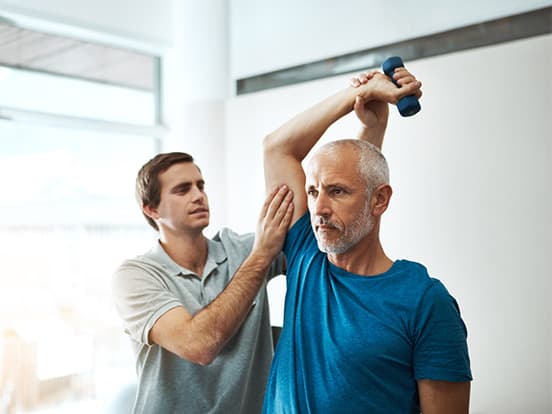How’s your home office health
Protect yourself from workspace woes
Clinically reviewed by Mitch Collings
Written by Imogen Comrie
Published on 30/10/2023
For many office workers, the pandemic brought in a pretty big change: remote working. Who doesn’t love the convenience of working from home, the extra time in bed, being able to stick a wash on, and the flexibility it gives us? We have a hybrid policy here at Simplyhealth that we feel gives everyone the best of both worlds.
However, with home working comes the potential impact on physical health and the risk of Musculoskeletal (MSK) conditions. But before you consider rushing back to the office, read on for our home office health check...
Growing Pains: MSK
MSK conditions are on the rise. According to the World Health Organization (WHO), MSK conditions are now the leading cause of disability globally, affecting over 1.7 billion people worldwide. The Office for National Statistics showed that back and neck problems have been rising since 2019 and are now the second-highest reason for people leaving work.
Repetitive strain injury, or RSI, is also a common complaint when discussing working from home - RSI is an irritation of the soft tissue resulting in pain and stiffness, brought on by repeated movements. Treatment and improving ergonomic set-ups can help reduce the condition quickly, which is why we need to keep home workspaces working for us, rather than against us. Let's take a closer look.
Remote Work Blues
For all the benefits, there are drawbacks to working from home:
Bad ergonomics: Many remote workers lack proper, RSI-beating ergonomic setups at home. Using a kitchen table or chair, hunching over a makeshift desk, or ignoring that niggling pain in our wrist, can lead to poor posture or even chronic conditions.
Too still for too long: It feels boring to mention it, but we all know by now that long hours of sitting in front of a computer screen aren’t doing us any favours. A sedentary lifestyle can cause muscle imbalances, weakened core muscles, and reduced circulation - all of which contribute to MSK issues.
Missing your colleagues: OK, so maybe you don’t want to see your colleagues every day, but isolation and limited social interaction can lead to stress and anxiety. This can actually manifest as tension and discomfort in the muscles! Do coffee machine chats seem more tempting now?
Living to work: Have you found that the boundary between work and personal life is so much more blurred when working from home? Extended work hours, and less time for relaxation, exercise, and life, isn’t helping anybody.

Working from home a pain in the neck?
Our members get discounted physiotherapy sessions with Ascenti for only £39.50 and can claim costs back through their plan. Join today from £23 per month.
Want to make some serious improvements?
Check out our three steps for a healthier home office:
Step One: Ergonomic Mastery
One of the first steps in preventing MSK discomfort while working from home is levelling up your workspace:
Find a supportive seat: Get a chair with proper lumbar support. It could be pricey, but it’s a worthwhile investment for your posture. It’s also important that your chair fits you properly, so make sure to buy a chair suitable for your size.
Adjust your desk height: Your desk should be a height that allows your arms to be parallel to the floor when typing.
Monitor placement: Your computer monitor should be at eye level and about an arm's length away.
Mindful breaks: Take short, frequent breaks to stand, stretch, and move around. Set reminders using an app or an alarm to remind yourself.

Step Two: Posture Matters
Here's how to improve and maintain good posture:
Sit up straight: Your back should be upright and fully supported by the chair's backrest. Try not to slouch or lean forward, even when it feels like the day will never end!
RSI advice: When typing, your wrists should be in a neutral position, not angled up or down. People sometimes use a tilted keyboard, but this can lead to an extended wrist position which can aggravate the muscles in the hand. A neutral wrist position reduces this risk.
Flat feet: Keep your feet flat on the ground, or on a footrest, for a neutral spine position.
Get stretching: Add some simple stretching exercises into your daily routine to release tension (and because it feels good). Try stretching a bit every hour.
Mitch Collings says:
A supportive ergonomic set-up with good back support can reduce the risk of developing musculoskeletal conditions such as repetitive strain injuries.
A good starting place to check your sitting posture is using the 90/90/90 rule. Ensure your feet are flat on the floor, knees, and hips at 90 degrees, your back is supported by the backrest, and the curve of your lumbar spine fits the curve of the lumbar support. Shoulders should be relaxed with your elbows by your side at 90 degrees when typing or using the mouse. The head should be in a neutral position when looking at the screen. This starting posture can then be adjusted in small increments based on personal comfort.
Step Three: Daily Habits
Small, healthy daily habits can make a big difference to your MSK health:
So many activities: Regular physical activity is essential. Try effective yet gentle exercise like yoga or Pilates, get out for a walk, or lift weights. You don't even need to go to a gym, use exercise classes on YouTube!
Stay hydrated: Water helps your muscles, joints, and skin. Plus, all those trips to the loo will add to your physical activity.
Break time: Health is mental, too. Take time to relax and release tension. Deep breathing exercises can be incredibly beneficial, so take advantage of being at home, away from distractions. Good luck to those of you with kids or pets, though!
Consult a specialist: If you're experiencing persistent MSK discomfort, seek the advice of your GP or a healthcare professional for tailored guidance. With a Simplyhealth plan, you can access physio/osteo/chiro and podiatry benefits when you need it!

Mitch's closing words
Working from home can be great in some respects, but it has its own risks. Poor ergonomic set-ups are a significant risk factor of musculoskeletal aches and pains, and working from home can be isolating if you don’t have strong social connections. A home office can also be a reminder of work even outside of working hours, so it’s critical that positive habits are created to reduce these risks.
Remember:
Your best posture is your next posture. Even the best sitting postures are still static postures, so ensure you regularly take postural breaks to move around and stretch.
Create end-of-day habits such as packing away the office equipment or writing a to-do list for the following day to help recognise the difference between work time and home time.
Musculoskeletal aches and pains can be distracting and can impact your focus and productivity. An optimal ergonomic set-up can help to change that; a better ergonomic place leads to a better thinking space.
Reviewed by Mitch Collings
Mitch Collings BSc (Hons), MCSP, Technical Member ACPOHE, has worked at Ascenti for over four years, beginning his career as a graduate physiotherapist before progressing into Clinical Mentor, Physiotherapy Development Lead, Occupational Health Service Lead, and Area Manager roles.
As a driven individual who is passionate about providing fantastic patient care, these roles have enabled him to develop a breadth of specialist knowledge and a diverse skill set, including complex case management and ergonomic assessments.
You can connect with Mitch via LinkedIn.
Written by Imogen Comrie
Imogen Comrie is a freelance writer and campaign designer based in the UK. She studied copywriting and strategy at Berghs School of Communication in Stockholm before specialising in B2B communications. She has extensive experience in social media and devising multi-channel campaigns.
You can connect with Imogen via LinkedIn.
It’s time to do something about the aches and pains
Get access to discounted physiotherapy sessions with Ascenti when you join Simplyhealth. Plans start from £23 per month.
You might also be interested in...

Healthy Living Hub
Our collection of articles and resources focused on your health and well-being,covering topics like women's health, online GP services and more.

Health treatments explained
Find out more about the health treatments covered on our plans, including what's included in the counselling and advice support line service.
This material may contain links to other websites operated by third parties. It is the responsibility of third parties to ensure such material and websites comply with all relevant laws and regulations. To the maximum extent permissible by law Simplyhealth disclaims all responsibility for such websites.